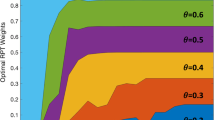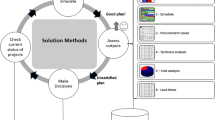Abstract
We consider a project scheduling environment in which the activities are partitioned among a set of agents. The owner of each activity can decide its length, which is linearly related to its cost within a minimum (crash) and a maximum (normal) length. For each day the project makespan is reduced with respect to its normal value, a reward is offered to the agents, and each agent receives a given ratio of the reward. As in classical game theory, we assume that the agents’ parameters are common knowledge. We study the Nash equilibria of the corresponding non-cooperative game as a desired state where no agent is motivated to change his/her decision. Regarding project makespan as an overall measure of efficiency, here we consider the worst and the best Nash equilibria (i.e., for which makespan is maximum and, respectively, minimum among Nash equilibria). We show that the problem of finding the worst Nash equilibrium is NP-hard (finding the best Nash equilibrium is already known to be strongly NP-hard), and propose an ILP formulation for its computation. We then investigate the values of the price of anarchy and the price of stability in a large sample of realistic size problems and get useful insights for the project owner.



Similar content being viewed by others
References
Agnetis, A., Briand, C., Billaut, J.-C., & Šucha, P. (2015). Nash equilibria for the multi-agent project scheduling problem with controllable processing times. Journal of Scheduling, 18(1), 15–27.
Ahuja, R. K., Magnanti, T. L., & Orlin, J. B. (1993). Network flows. Upper Saddle River, NJ: Prentice-Hall.
Anshelevich, E., Dasgupta, A., Kleinberg, J., Tardos, É., Wexler, T., & Roughgarden, T. (2008). The price of stability for network design with fair cost allocation. SIAM Journal on Computing, 38(4), 1602–1623.
Averbakh, I. (2010). Nash equilibria in competitive project scheduling. European Journal of Operational Research, 205(3), 552–556.
Briand, C., Ngueveu, S. U., & Šucha, P. (2017). Finding an optimal Nash equilibrium to the multi-agent project scheduling problem. Journal of Scheduling, 20, 475–491.
Christodoulou, G., & Koutsoupias, E. (2005). On the price of anarchy and stability of correlated equilibria of linear congestion games. In G. S. Brodal, & S. Leonardi (Eds.), Algorithms—ESA 2005. ESA 2005. Lecture Notes in Computer Science (Vol. 3669, pp. 59–70). Berlin: Springer.
Ciurea, E., & Ciupalâ, L. (2004). Sequential and parallel algorithms for minimum flows. Journal of Applied Mathematics and Computing, 15, 53–75.
Confessore, G., Giordani, S., & Rismondo, S. (2007). A market-based multi-agent system model for decentralized multi-project scheduling. Annals of Operations Research, 150, 115–135.
De Ita Luna, G., Zacarias-Flores, F., & Altamirano-Robles, L. C. (2015). Finding pure Nash equilibrium for the resource-constrained project scheduling problem. Computación y Sistemas, 19(1), 17–27.
De Reyck, B., & Herroelen, W. (1999). The multi-mode resource-constrained project scheduling problem with generalized precedence relations. European Journal of Operational Research, 119, 538–556.
Demeulemeester, E. L., & Herroelen, W. S. (2002). Project scheduling—A research handbook. Dordrecht: Kluwer.
Demeulemeester, E., Vanhoucke, M., & Herroelen, W. (2003). Rangen: A random network generator for activity-on-the-node networks. Journal of Scheduling, 6, 17–38.
Estévez-Fernández, A. (2012). A game theoretical approach to sharing penalties and rewards in projects. European Journal of Operational Research, 216(3), 647–657.
Herroelen, W. S., & De Reyck, B. (1999). Phase transitions in project scheduling. Journal of the Operational Research Society, 50(2), 148–156.
Kolisch, R., Sprecher, A., & Drexl, A. (1992). Characterization and generation of a general class of resource-constrained project scheduling problems. Institut für Betriebswirtschaftslehre Christian-Albrechts-Universität zu Kiel, working paper no. 301.
Phillips, S., & Dessouky, M. I. (1977). Solving the project time/cost tradeoff problem using the minimal cut concept. Management Science, 24(4), 393–400.
Van Eynde, R. (2017). Multi-project scheduling—The application of a decoupled schedule generation scheme and a game mechanic, Master’s Dissertation in Business Engineering, Universiteit Gent.
Varakantham, P., & Fu, N. (2017). Mechanism design for strategic project scheduling, research collection school of information systems. Singapore Management University, 8-2017.
Acknowledgements
This work was supported by the European Regional Development Fund under the project AI&Reasoning (Reg. No. CZ.02.1.01/0.0/0.0/15_003/0000466).
Author information
Authors and Affiliations
Corresponding author
Additional information
Publisher's Note
Springer Nature remains neutral with regard to jurisdictional claims in published maps and institutional affiliations.
Appendices
ILP model
where
Complexity of finding a base strategy
Theorem 3
As long as activity durations can only attain integer values, the problem of finding a base strategy is NP-complete.
Proof
The problem clearly belongs to NP. Its NP-completeness can be shown by reducing 3-Partition to this problem.

Construction in the proof of Theorem 3, when \(k=4\). Arc labels denote crashing costs
Consider an arbitrary instance of 3-Partition. We construct an instance of the base strategy problem as follows (see Fig. 4). The activity-on-arc graph G has 3k parallel paths \(P_l, l \in 1,\ldots , 3k\), each consisting of k arcs (and hence, \(k+1\) nodes). There are also two nodes 0 and \(3k(k+1)+1\), representing the beginning and the end of the project respectively. There are also 3k dummy activities from node 0 to the beginning of each path and 3k dummy activities from the end of each path to node \(3k(k+1)+1\). Moreover, there is one extra activity\((0, 3k(k+1)+1)\). There are \(m=k\) agents, where agent \(A_u\) owns the \(u^{th}\) activity of each path \(P_l\), \(u=1,\dots ,k\). All the activities of the 3k paths have \(\underline{p}_{ij}=0\) and \(\overline{p}_{ij}=1\). All the dummy activities have fixed length equal to 0. The crashing cost of all the k activities of path \(P_l\) is \(a_l\), \(l=1,\dots ,3k\). The extra activity \((0, 3k(k+1)+1)\) has fixed length \(\underline{p}_{ij}=\overline{p}_{ij}=k-1\) and it is associated with an arbitrary agent. Because of the extra activity, for any strategy the project makespan is always at least \(k-1\).
The reward is \(\pi = k B\), and it is shared equally, i.e., \(w_u = 1/k\), for all \(A_u \in \mathcal {A}\). Note that letting \({\bar{S}}\) denote the normal strategy, one has \(D({\bar{S}})=k\) and \(Z_u(\bar{S})=0\) for all agents \(A_u\) (from the definition of normal strategy). A strategy S such that \(D(S)=k-1\) can be attained by decreasing (from 1 to 0) exactly one activity for each path (decreasing more than one activity on the same path would have no effect on the makespan, because of the extra activity). The problem is therefore equivalent to asking whether there exists a strategy such that \(D(S)=k-1\) that is profitable for all agents. Letting P(u) denote the set of paths such that, in S, agent \(A_u\) decreased its activity, one has
So, if there exists a strategy S for which the profit of each agent is nonnegative and such that \(D(S) = k - 1\), then \(B-\sum _{j:P_j\in P(u)}a_j\ge 0\) for all u. For this to occur, each agent must, therefore, select exactly three distinct numbers \(a_i\) such that their sum equals B. This is possible if and only if a partition in the 3-Partition instance exists. \(\square \)
Rights and permissions
About this article
Cite this article
Agnetis, A., Briand, C., Ngueveu, S.U. et al. Price of anarchy and price of stability in multi-agent project scheduling. Ann Oper Res 285, 97–119 (2020). https://doi.org/10.1007/s10479-019-03235-w
Published:
Issue Date:
DOI: https://doi.org/10.1007/s10479-019-03235-w





